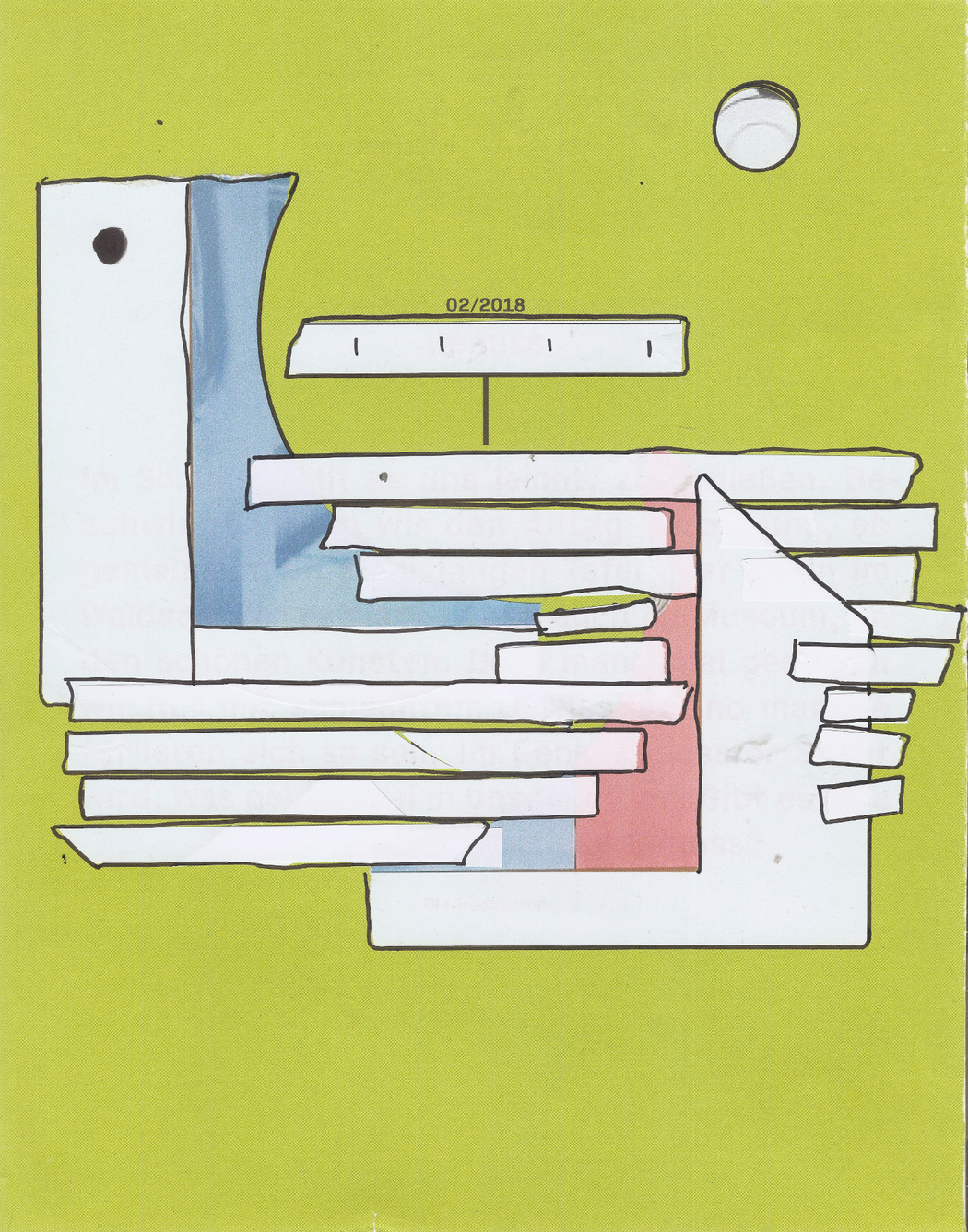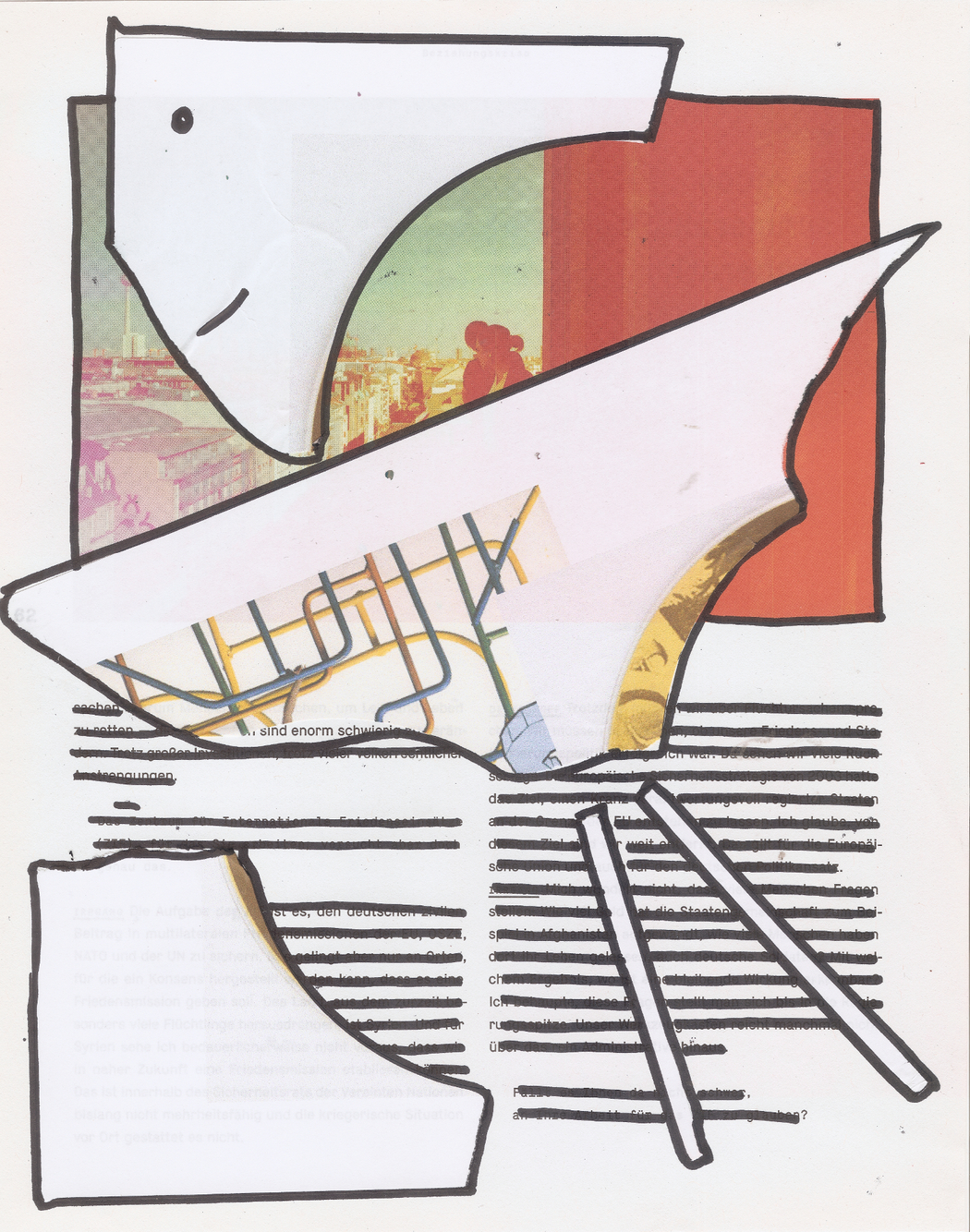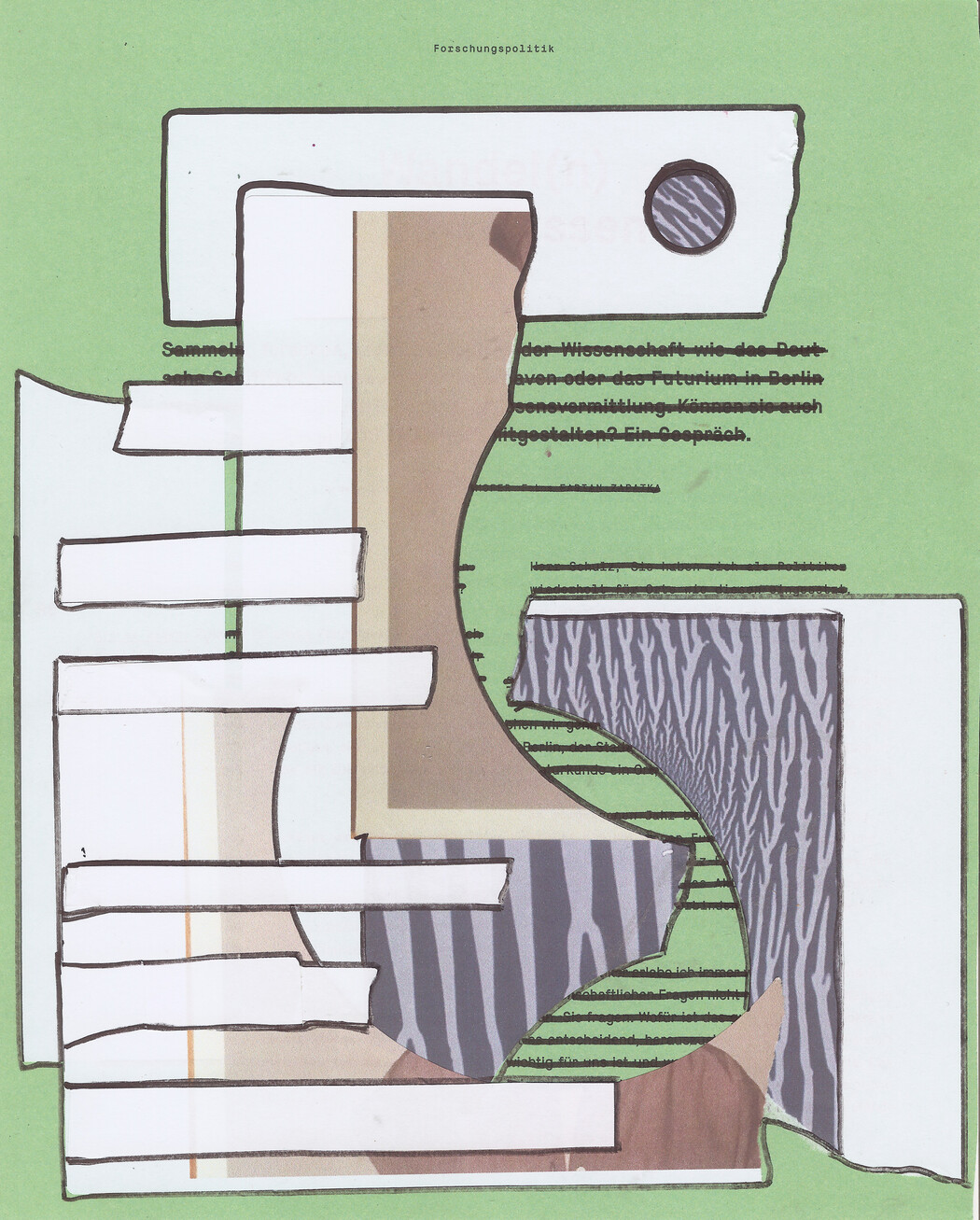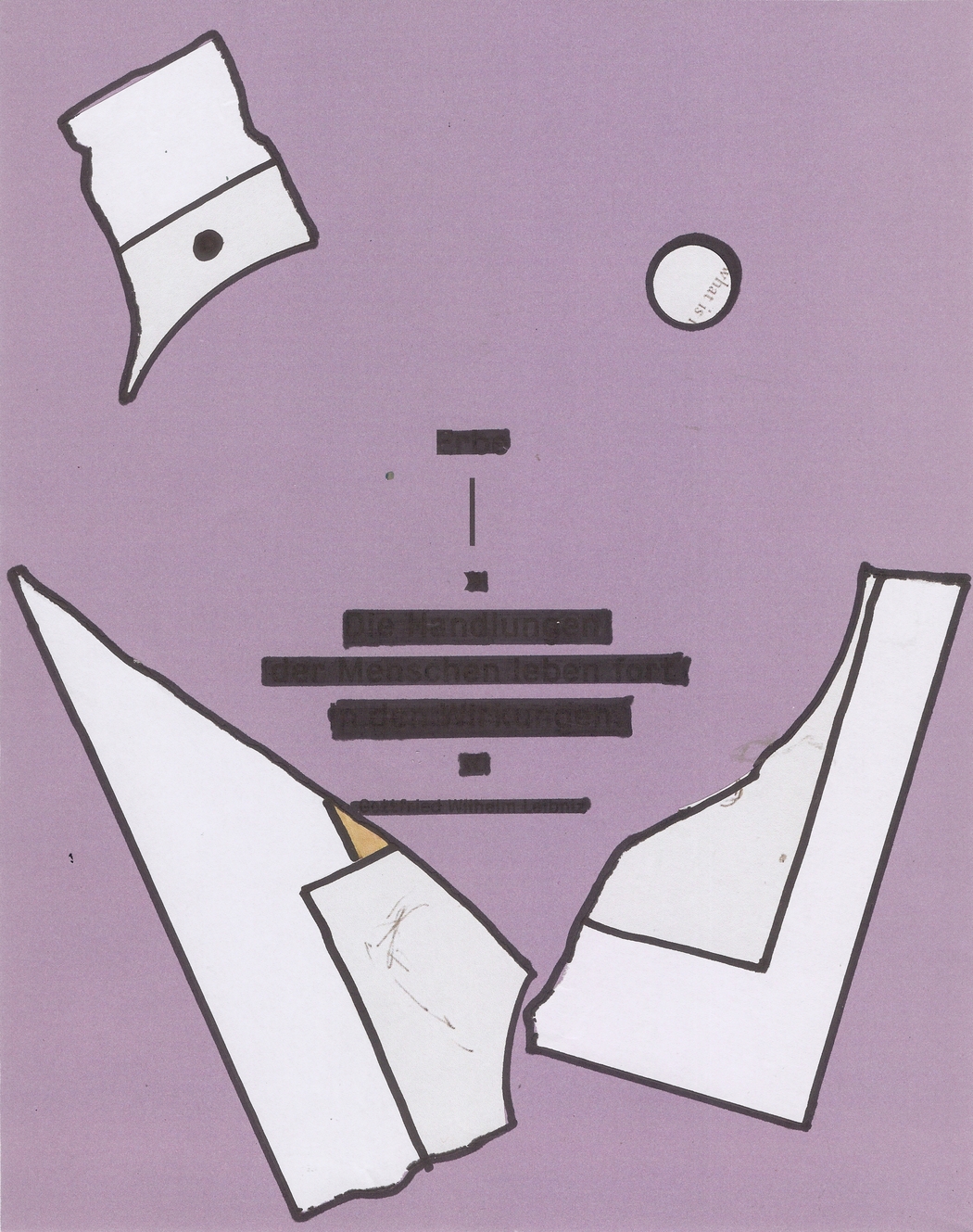Oliver Orthuber
Year of birth: 1970
Where do you live: Berlin, Germany
Your education: I studied architecture and graduated with a diploma in 1999.
Describe your art in three words: Experimental Deconstructivist Intertextual
Your discipline: is visual art, with a strong focus on experimental approaches and interdisciplinary works that combine music, literature, and the visual arts.
Website | Instagram
 Oliver Orthuber | Forschungspolitik | 2025
Oliver Orthuber | Forschungspolitik | 2025
Your work revolves around the concepts of repetition and difference. How do these ideas influence your creative process and the final pieces?
Repetition and difference are the central principles of my work, shaping both my creative process and the final piece. In my series _Copy Sample Remix – TGSW (Tearing Geometric Sticker Work)_, I deliberately work with overpainting and transformation. I take an existing work as a starting point, highlight certain elements, cover or alter them, creating a tension between continuity and change.
This method leads to a process in which the old never completely disappears but continues to exist as a fragment, influencing the new composition. Repetition manifests in the ongoing engagement with existing structures, while difference emerges in the moment of transformation – in the revelation of new layers, in the chance occurrences that result from conscious and unconscious interventions.
The interplay between control and chance is essential to my approach. The deliberate act of tearing stickers or the random repetition of prints generates a raw, almost anarchic energy that keeps my work alive. Similar to collage or Dadaism, I use fragmentation and unpredictability as design elements, creating a kind of visual archaeology: each layer tells its own story, and the final piece becomes a palimpsest, merging different temporal and interpretative layers.
Ultimately, my artistic process is open and experimental. There is no predetermined final outcome – the work evolves organically, responding to the material and existing structures. This unpredictability leads to qualitative leaps, breaks, and transitions, giving the artwork a dynamic presence. In this sense, my art is not linear or rational but rather multilayered, fragmented, and process-oriented – and this is precisely what makes it so compelling to me.
Can you describe the role of overpainting in your art? How do you decide which elements to alter and which to keep intact?
In my artistic practice, the tension between control and chance is essential. I consciously work with both forces, allowing them to interact in an open, experimental process. Control is evident in my deliberate selection of materials, composition, and intentional overpainting. Chance, on the other hand, emerges where I allow materials to develop independently—whether through the tearing of stickers, the layering of surfaces, or the intentional acceptance of spontaneous developments.
In this way, my process echoes **Guy Debord’s concept of “Dérive”**, the act of drifting through urban space as a means of expanding perception. However, whereas Debord explored the city physically, my approach translates this drifting into a mental realm. My materials and techniques lead me through a creative labyrinth: I follow the traces of existing structures, layers, and remnants without adhering to a fixed plan. The works emerge from a kind of mental wandering—an intuitive process that does not follow a linear path but moves in unexpected directions.
This way of working resembles a form of visual archaeology, where each layer carries the traces of what came before, creating new levels of meaning. The combination of control and chance results in ruptures, transitions, and a dynamic energy that keeps my work alive. The final outcome remains open—serving as a unique document of a creative process unfolding between intention and surprise.
 Oliver Orthuber | 02/2018 | 2024
Oliver Orthuber | 02/2018 | 2024
The use of stickers and tearing in your series creates an interesting interplay between control and chance. Can you elaborate on how this tension influences the way you create your art?
The deliberate use of stickers that I create myself, combined with the intentional act of tearing, generates a unique tension between control and chance—an essential aspect of my artistic practice. Interestingly, even the production of my stickers follows the principle of Dérive, an intuitive, process-driven form of drifting that embraces chance and spontaneous decisions. While I design and produce them myself, their final form and surface texture often emerge through unpredictable variations in the production process.
This approach continues throughout my work: Stickers initially represent precision—they have a defined shape and a smooth, controlled surface. However, by integrating them into my compositions and then transforming them through tearing or layering, I deliberately disrupt this order, allowing uncontrolled, organic structures to emerge.
This act of deconstruction is not a purely random gesture but a conscious intervention. Every tear, every lifted or concealed layer creates new visual dimensions and unexpected compositions. The interaction between my intentional gestures and the material’s physical properties results in a dialogue between control and unpredictability.
This method recalls the aesthetics of décollage, where existing layers are stripped away or revealed to generate new meanings. At the same time, a visual tension emerges: the controlled placement of my self-made stickers—shaped by Dérive and chance—contrasts with the spontaneous, unpredictable forms created through tearing. As a result, each piece develops organically, oscillating between planned and accidental elements.
Through this experimentation with materiality and fragmentation, my work challenges traditional ideas of composition and completeness. The interplay of control and chance keeps the creative process alive—an open system in which new structures and meanings emerge from the fusion of precision, randomness, and unforeseen effects.
How do you see the concept of “visual archaeology” manifesting in your pieces? What do you hope viewers uncover when they look at the layers of your work?
The concept of “visual archaeology” manifests in my works through the layering and transformation of materials, where each new layer carries traces of the previous one. These layers act as remnants of the past, still visible yet redefined through acts of overpainting and fragmentation. For me, this constant layering and reinterpreting is an invitation not only to observe the artwork itself but also to discover the meanings that emerge through the dialogue between the layers.
In a way, I see my works as an open, intertextual fabric that allows space for the discovery of connections between various ideas and themes. Inspired by Walter Benjamin’s “Angel of History,” who looks upon the ruins of the past while being propelled into the future, I invite the viewers to uncover their own associations—whether with other artistic movements, literary works, or philosophical concepts. Like the angel, who is carried through the storm of time, viewers can navigate through the layers of my work, discovering “ruins” of the past that take on new meanings in the context of the present.
The beauty of this intertextual approach is that each viewer enters the work with their own history, experiences, and cultural contexts. This allows for different personal connections to other artistic, literary, or philosophical themes to emerge. One person might be reminded of Guy Debord’s Dérive and the open, aimless flow of time, while another might think of the fragmentations in James Joyce’s literature or the visual destruction found in Décollage artists’ works.
For me, it is essential that viewers uncover their own “layers” within the artwork—associations that are not explicitly given but arise through contemplation and interpretation. These intertextual discoveries offer not only a deeper engagement with the art but also a reflection on the complexity of memory, history, and perception. In this way, each piece becomes an open text, which can be read and decoded by every viewer in their own way. The layers become an invitation to continually find new perspectives and to discover a personal meaning within the work.
 Oliver Orthuber | Enorm schwierig ist ziemlich leicht | 2024
Oliver Orthuber | Enorm schwierig ist ziemlich leicht | 2024
In your statement, you mention that the process of creating your work is open-ended. Can you talk more about the unpredictability of this approach and how it shapes the outcome?
Unpredictability is a central aspect of my creative process and plays a crucial role in the development of my works. By choosing an open-ended approach, I give the work the freedom to evolve in unforeseen directions. This means that when creating my pieces, I don’t know exactly what the final result will look like. Instead, I trust that new ideas and formations will emerge during the process—both from the materials themselves and from the spontaneous interplay of action and chance.
The moment of unpredictability particularly arises through the use of materials that are partly shaped by randomness and uncontrollable processes. For example, the act of tearing stickers or overpainting is not something I can fully plan. The texture created by tearing, the behavior of paint on different layers—these are factors that I cannot completely control. This randomness brings an exciting dynamic to the work and leads to constant, unexplored transitions and visual surprises.
At the same time, I consciously avoid having a fixed end goal to allow space for this unpredictability. It’s like an experiment where I play with the elements, putting them into new, unfamiliar relationships. This openness in the creative process, however, is not chaotic; it follows its own rhythm that emerges from the interaction between the materials and my actions. The result is never predetermined but unfolds in a continuous dialogue between the different layers and elements of the piece.
Unpredictability allows me to play with the idea of art as something alive and changing. It challenges the notion that art should be something static or finished. Instead, it becomes an open, dynamic process that is never truly “complete.” Therefore, the outcome is never what I expected at the beginning but something that unfolds during the creative process, offering new perspectives both to me and hopefully to the viewers as well.
Dadaism and collage art seem to influence your approach. In what ways do you find these movements relevant to your work today?
Dadaism and collage art are still highly relevant to me, as they offer concepts and approaches that align well with the dynamics of my own work. Both movements introduced a fundamental break with traditional forms and structures in art, emphasizing chance, irrationality, and playing with perception. These concepts resonate strongly in my creative process.
Dadaism, with its rejection of established norms and its focus on chance and spontaneous interventions, particularly inspires me because it liberates art from rationality and shifts it into the realm of the absurd and uncontrollable. By using collage elements and consciously breaking patterns, I create space for a similar kind of boundary-pushing, where the development of the work is always unexpected and non-linear. My overpainting and layering of materials can be understood as a kind of visual collage, where different elements come together to generate a new, unexplored meaning.
The influence of collage art is evident in my technique of combining and layering materials. The practice of joining disparate elements—whether by gluing, tearing, or overpainting—allows me to use fragmentation and contradiction to create a new, complex composition. Like in collage art, these breaks and combinations form a new image that may initially appear disjointed, but in its entirety, can find an unexpected harmony.
For me, Dadaism and collage art remain essential artistic tools that enable me to push the boundaries of traditional visual language and understand art as an open, dynamic process. These movements showed me that art doesn’t necessarily have to be rational or coherent, but can develop deeper, often unexplored meanings through breaks, chance, and fragmentation. In this sense, I find their ideas still very relevant and inspiring for my work today.
 Oliver Orthuber | Forschungspolitik | 2023
Oliver Orthuber | Forschungspolitik | 2023
How do you view the relationship between the materials you use (stickers, acrylic markers, paper) and the conceptual ideas behind your art?
The materials I use – self-made stickers, acrylic markers, and paper – are not just physical tools for me; they carry a conceptual significance that is deeply intertwined with the ideas behind my art. They serve as the “language” through which I express my concepts and thoughts, and each material has its own history and symbolism that I consciously incorporate into my work.
The self-made stickers are particularly important, as they bridge the gap between reproduction and individual creation. Being self-designed, they possess a personal, handcrafted character, which contrasts with industrially produced mass objects. At the same time, their use calls to mind Dadaism and collage art, where the transformation of everyday objects into artworks played a central role. The act of tearing, overpainting, and rearranging these stickers speaks to the shifting of meaning and opens up new perspectives. In my work, they symbolize the interaction between the existing and the newly emerging.
Acrylic markers and paper then come into play as more precise means to create shapes, lines, and structures. The acrylic marker allows me to work in a controlled, almost precise manner, while the paper provides a foundation where the various materials can unfold. For me, paper has an almost archaeological quality – it carries the traces of previous interventions and is constantly transformed as new layers are added. This creates a dynamic interplay between the materials.
Overall, I see the materials as parts of an open, ever-changing system that reflects the conceptual ideas of my work. They are both the carriers and the products of the creative process, where control, chance, and transformation merge. Each material brings its own energy and dynamics to the creation process, contributing to the development of a piece that communicates on multiple levels – both visually and conceptually. The self-made stickers are not just a material, but a concept in themselves, representing the open dialogue between the past, present, and future in my art.
 Oliver Orthuber | Meinst Du| 2024
Oliver Orthuber | Meinst Du| 2024

Leave a Reply